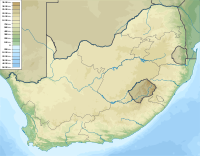
The Kgalagadi Transfrontier National Park is a cross-border national park in the northwest South Africa, or southwest Botswana.
background
| location | ||

Today's Kgalagadi Transfrontier Park emerged from the amalgamation of the former South African Kalahari Gemsbok National Park and the former Botswana Gemsbok National Park and covers 38,000 km². The state border runs along the dry Nossob River. The smaller South African part forms the northernmost tip of the province Northern Cape. The area of the Kalahari Gemsbok National Park is considered to be Khomani cultural landscape. It has been settled since the Stone Age, and the vast, barren land has shaped the way of life, knowledge and culture of its inhabitants. Since 2017 this landscape belongs to the UNESCO world cultural heritage.
getting there
By plane
The next airport is Upington. A runway that can be approached with small fan guns is located near Twee Rivieren.
By bus
In the street
The journey from South Africa is almost mandatory Upington. From there about 250 km on a well-developed road north to the entrance gate at Twee Rivieren
There are also two Botswana entrances as well as an entrance at Mata-Mata Camp, via which a driveway leads out Namibia is possible.
mobility
Visiting the park without your own vehicle does not make sense, if at all possible. There are only natural roads or slopes in the park. The maximum permissible speed is 50 km / h. While the main roads on the South African side are passable with a normal PWK, an all-wheel drive vehicle is necessary on the Botswana side. On the South African side, too, many side streets are not allowed to be driven on with a normal car and some are only reserved for visitors to certain camps.
As in many nature parks, vehicles may only be left at designated rest areas.
Petrol and diesel are only available in the larger camps Twee Rivieren, Mata-Mata and Nossob.
You can move around the entire park without border controls. However, the park must be left on the side of the border that you entered. The Mata-Mata border crossing to and from Namibia has been open again since 2007. However, 2 nights in the national park are compulsory. There are also border stations in Twee Rivieren for the onward journey to South Africa or Botswana.
Tourist Attractions



Here you will find a wonderful arid landscape. The park was not called for nothing Gemsbok National Park, because gemsbok (oryx antelopes) can actually be seen everywhere. In addition, of course, a lot of other antelope species, sometimes considerable ostrich herds and giraffes and last but not least lions, cheetahs and, with a little luck, a leopard.
More information about the animals and plants in Africa can be found in the topic article African flora and fauna.
activities
We recommend an organized night drive, on which you can also see the nocturnal animals of the park.
shop
There are shops in Twee Rivieren, Mata Mata and Nossob. The shops in the camps are well sorted. The supply of basic food is largely given. Only fresh fruit and vegetables are only available in very limited quantities. Ultimately, you can also make a stop on the journey to Upington and stock up on supplies.
kitchen
The only restaurant is in Twee Rivieren Camp.
nightlife
accommodation

Accommodation can be booked up to eleven months before the arrival date Sanparks get booked. Early booking is recommended, as the Wilderness Camps in particular are often fully booked a few hours after the release date.
Twee Rivieren, Mata Mata and Nossob are the three larger camps on the South African side. There are very nice chalets in these camps, as well as immaculate campsites with electricity. However, anyone who expects grass will be disappointed. (After all, we are in the Kalahari.) Twee Rivieren is right at the entrance from the Upington direction, Mata Mata right on the Namibian border. Nossob is located on the river of the same name, often dried up, in the heart of the park.
Bitterpan, Grootkolk, Kieliekrankie, Urikaruus, Gharagab and Kalahari Tent Camp are smaller, non-fenced wilderness camps to which you have to bring your own firewood and drinking water. There are no camping facilities in these camps. Registration for overnight stays is only possible in the large camps mentioned above.
security
health
Practical advice
The South African information center is located in Twee Rivieren. Tel .: 054 561 2000, Fax: 054 561 2005.
Public telephones are only available in Twee Rivieren. Cell phone reception is possible in Twee Rivieren, but not in the rest of the park. There is no public internet access.

